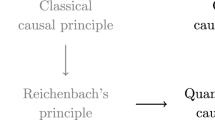Abstract
Attemts to explain causal paradoxes of Quantum Mechanics (QM) have tried to solve the problems within the framework of Quantum Electrodynamics (QED). We will show, that this is impossible. The original theory of QED by Dirac (Proc Roy Soc A117:610, 1928) formulated in its preamble four preliminary requirements that the new theory should meet. The first of these requirements was that the theory must be causal. Causality is not to be derived as a consequence of the theory since it was a precondition for the formulation of the theory; it has been constructed so that it be causal. Therefore, causal paradoxes logically cannot be explained within the framework of QED. To transcend this problem we should consider the following points: Dirac himself stated in his original paper (1928) that his theory was only an approximation. When he returned to improve the theory later (Proc Roy Soc A209, 1951), he noted that the new theory “involves only the ratio e/m, not e and m separately”. This is a sign that although the electromagnetic effects (whose source is e) are magnitudes stronger than the gravitational effects (whose source is m), the two are coupled. Already in 1919, Einstein noted that “the elementary formations which go to make up the atom” are influenced by gravitational forces. Although in that form the statement proved not to be exactly correct, the effects of gravitation on QM phenomena have been established. The conclusion is that we should seek a resolution for the causal paradoxes in the framework of the General Theory of Relativity (GTR)—in contrast to QED, which involves only the Special Theory of Relativity (STR). We show that causality is necessarily violated in GTR. This follows from the curvature of the space-time. Although those effects are very small, one cannot ignore their influence in the case of the so-called “paradox phenomena”.
Similar content being viewed by others
References
Bell J.S. (1967) On the Einstein-Podolsky-Rosen paradox, Physics 1: 195
Bohm D., Aharonov Y. (1957) Discussion of experimental proof for the paradox of Einstein, Rosen and Podolsky. Physical Review 108: 1070–1076
Castellani E. (2004) Dirac on gauges and constraints. International Journal of Theoretical Physics 43(6): 1503–1514
Dirac P.A.M. (1928) The quantum theory of the electron. Proceedings of the Royal Sociey of London A 117: 610–624
Dirac P.A.M. (1929) A theory of electrons and protons. Proceedings of the Royal Society of London A 126: 360–365
Dirac P.A.M. (1930) The principles of quantum mechanics. Clarendon Press, Oxford
Dirac P.A.M. (1951) A new classical theory of electrons. Proceedings of the Royal Society of London A 209: 291–295
Dirac P.A.M. (1964) Lectures on quantum mechanics. Academic Press, New York
Einstein, A. (1919) Spielen Gravitationsfelder in Aufber der materiellen Elementarteilchen eine wesentliche Rolle? Sitzungsberichte der Preussischen Akad. D. Wissenschaften, 82, 1919, 349–356. (English translation: Do gravitational fields play an essential part in the structure of the elementary particles of matter? In Dover (1952) The Principle of Relativity (pp. 191–198)).
Einstein A., Podolsky B., Rosen N. (1935) Can quantum mechanical description of physical reality be considered complete?. Physical Review 47: 777–780
Fine, A. (1991). Inequalities for nonideal correlation experiments. Foundations of Physics, 21, 3. http://www.springerlink.com/content/n4u55357401q6u2l/fulltext.pdf
Fine A., Szabó L.E. (2002) A local hidden variable theory for the GHZ experiment. Physics Letters A 295: 229–240
Szabó L.E. (2000a) On an attempt to resolve the EPR-Bell paradox via Reichenbachian concept of common cause. International Journal of Theoretical Physics 39: 911
Szabó L.E. (2000b) On Fine’s resolution of the EPR-Bell problem. Foundations of Physics 30: 1891–1909
Szabó, L. E. (2008). The Einstein–Podolsky–Rosen argument and the Bell inequalities, Internet Encyclopedia of Philosophy.
Author information
Authors and Affiliations
Corresponding author
Rights and permissions
About this article
Cite this article
Darvas, G. Can the Causal Paradoxes of QM be Explained in the Framework of QED?. Found Sci 14, 273–280 (2009). https://doi.org/10.1007/s10699-009-9159-x
Published:
Issue Date:
DOI: https://doi.org/10.1007/s10699-009-9159-x




